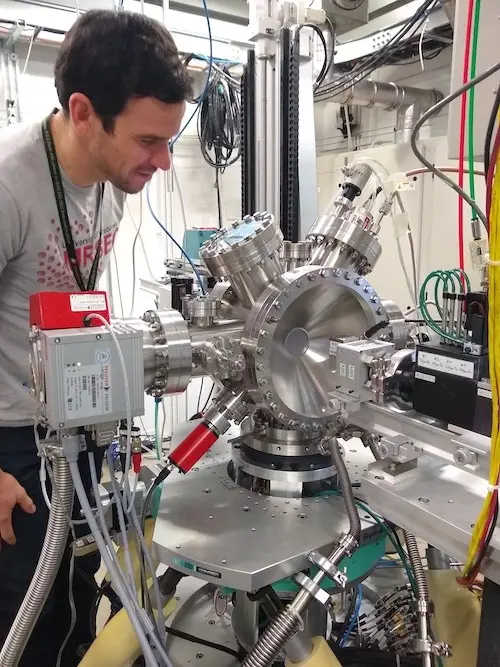A team of researchers from the NSF-funded Wisconsin Materials Research Science and Education Center (MRSEC) at the University of Wisconsin–Madison has designed, constructed, and implemented a new, highly specialized piece of research equipment that can be used to visualize the real-time formation and growth of tiny crystals of novel materials. The unique perspective provided by this approach provides access to new ways to discover and develop materials relevant to electronics, optics and magnetic applications.
 MS&E PhD student Samuel Marks helped design, build and install the Wisconsin MRSEC X‑ray Endstation for Nanoscale Transformations (MXNT) at Argonne National Laboratory.
MS&E PhD student Samuel Marks helped design, build and install the Wisconsin MRSEC X‑ray Endstation for Nanoscale Transformations (MXNT) at Argonne National Laboratory.
In collaboration with researchers at the U.S. Department of Energy’s (DOE) Argonne National Laboratory in Lemont, Illinois, the MRSEC researchers, including Professor Paul Evans and his graduate students in materials science and engineering as well as Professor Emeritus Thomas Keuch, designed this instrument, which is referred to as the Wisconsin MRSEC X-ray Endstation for Nanoscale Transformations (MXNT).
The MXNT incorporates optics for focusing x-rays and a specialized deposition chamber for creating compositionally precise and extremely thin layers of materials. The purpose of the MXNT is to measure and observe molecular processes and material structures at the scale of nanometers. For scale, one nanometer is less than half the diameter of a strand of DNA, about 0.00001 times the size of a human hair, or the equivalent of about three times the spacing between atoms. Uniquely, the MXNT instrument allows x-rays to be focused to very small spot sizes of only a few hundred nanometers during experiments studying crystallization, an important technical leap over previously available instrumentation for studying this type of materials synthesis.
The MXNT has been installed and used at Argonne, where it was integrated with an existing instrument located there as part of the Advanced Photon Source (APS), a DOE Office of Science User Facility. This setup at beamline 12-ID-D allows the MXNT to access the very bright x-rays created by the APS, which are about a billion times brighter than x-rays generated by instrumentation available on the UW campus. These bright x-rays are part of what gives the MXNT the ability to achieve such precision in its studies of the structure of materials.
With the MXNT, the researchers can probe the formation of crystals. Structural features serve as the fingerprints of the processes of crystal growth and provide insights that can help researchers to create crystals that have not previously been possible. For example, precise control over crystallization is increasingly important in the design and synthesis of advanced materials, such as those in electronic and magnetic devices, materials for advanced optics, and in the catalysis of chemical reactions. With this approach, the key steps of the crystal growth, and the fundamental scientific issues involved, can be investigated much more precisely than was possible in the past.
“This new capability is incredibly important to understand how crystals grow in situ in order to better design new materials for real-world applications,” says Nicholas Glavin, materials scientist at the Air Force Research Laboratory and one of the researchers who worked on the project, “and the MXNT is a vital tool to truly understand the complex origins of crystal growth.”
For researchers, there are significant challenges associated with precisely creating desired crystals and controlling the arrangement and orientation of the atoms within them. A particularly challenging set of problems involves compounds that have multiple crystal structures, each with very different physical properties, even when they are made up of the same chemical components. The chemical constituents of crystals can be arranged in vastly different ways depending on the conditions under which they are formed. The MRSEC researchers are addressing this set of challenges in a class of materials, known as complex metal oxides, by developing a synthesis method based on the growth of crystals via a transformation between two solid forms of the same compound. The MXNT allows the researchers to target materials that have promising electronic properties and those that can serve as the template for the crystallization of other important materials.
Argonne physicist Hua Zhou worked with the Wisconsin MRSEC team to install the new instrument at beamline 12-ID-D of the APS. He touted the strong collaboration with the University of Wisconsin and said this new instrument would be an enormous benefit to MRSEC scientists and the scientific community.
Over the next few years, the APS will undergo a massive upgrade of its electron storage ring, increasing both the brightness and coherence of the X-ray beams it generates. Zhou noted that the enhanced capabilities of the upgraded APS will allow scientists using MXNT to focus the X-ray beam down to much smaller sizes and capture images on faster time scales, which will enable more precise observation and measurement of materials in dynamic processes.
Construction of the new storage ring, an integral part of the APS upgrade, is scheduled for completion in 2024. At that time, the MXNT instrument will make its new home as part of the Coherent High-Energy X-ray Sector at beamline 28-ID.
The first full experiments utilizing the completed MXNT were conducted in early 2021. A paper based on the first results generated during the development of the MXNT has been published in the journal Review of Scientific Instruments.
Researchers, both at UW–Madison and other organizations, are currently collaborating with MRSEC researchers to develop additional project proposals that will utilize the MXNT at the APS. Researchers interested in using the MXNT can contact Paul Evans for more information.